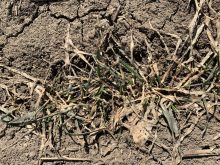Mild winter temperatures in Ontario have resulted in a healthy looking winter wheat crop but stripe rust poses a risk..
Why it matters: Last spring, many winter wheat acres were lost to a harsh winter and wet spring, so a solid wheat production year will be welcome.
Joanna Follings, cereals specialist with OMAFRA, says farmers were able to plant early last fall, leading to high winter wheat survival.

“That gave us an advantage in terms of having the chance (for the wheat) to be well tillered, and have a good root system developed before going into winter.”
Parts of southern Ontario had lower snowfall than other areas but should still have high wheat survival so long as it reached its winter hardy stage, which Follings says it did.
As of mid-March, winter wheat stands were greening up in the Chatham-Kent and Essex areas, said Follings.
Farmers may think winter wheat is often lost during winter’s cold but the crop is actually more fragile during late March and early April as it starts actively growing.
“If temperatures start to dip very quickly (during this time), even at night, or an event where we have lots of water sitting in the fields for long periods of time, this is where we tend to see issues,” says Follings.
Read Also

Senft to step down as CEO of Seeds Canada
Barry Senft, the founding CEO of the five-year-old Seeds Canada organization is stepping down as of January 2026.
Disease pressure always an issue in wheat
Albert Tenuta, field crop pathologist with OMAFRA, says some crop diseases survive no matter how cold it is in winter..
“You will see fluctuations (of disease pressures endemic to Ontario), maybe 10 or 20 per cent up and down on the over-wintering potential but for most of them they will survive.”
Stripe rust doesn’t overwinter in Ontario but can travel on winds from the United States..
“Not so much because it’s mild here, but because it’s milder throughout most of the southern U.S., into the mid-U.S. production and the Great Lakes.”
Obligate parasites, those which survive in living tissue, have overwintered in the southern states and will make their way to Ontario with storm fronts.
Tenuta expects a stripe rust issue in winter wheat similar to the 2016 outbreak.
“This was because of a mild winter. The inoculant load or the amount of infection in the central and southern United States, was quite high and the spores ended up coming to Ontario very early.”
Tenuta says his colleagues in the southern U.S. are seeing more stripe rust earlier than in previous years and at higher levels.
“There is a potential risk on the stripe rust side of things, for producers.”
Tenuta and Follings say it’s important for producers to get out and assess their wheat for over-wintering and survival.
“Later on one of the first diseases that farmers will look for will be stripe rust. The earlier it comes in, the greater the potential risk. Stripe rust will be one of those diseases for concern for 2020,” says Tenuta.















